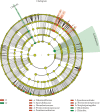Microbial Community Changes in the Rhizosphere Soil of Healthy and Rusty Panax ginseng and Discovery of Pivotal Fungal Genera Associated with Rusty Roots
- PMID: 32016120
- PMCID: PMC6985933
- DOI: 10.1155/2020/8018525
Microbial Community Changes in the Rhizosphere Soil of Healthy and Rusty Panax ginseng and Discovery of Pivotal Fungal Genera Associated with Rusty Roots
Abstract
Panax ginseng Meyer, a valuable medicinal plant, is severely threatened by rusty root, a condition that greatly affects its yield and quality. Studies investigating the relationship between soil microbial community composition and rusty roots are vital for the production of high-quality ginseng. Here, high-throughput sequencing was employed to systematically characterize changes in the soil microbial community associated with rusty roots. Fungal diversity was lower in the soils of rusty root-affected P. ginseng than in those of healthy plants. Importantly, principal coordinate analysis separated the fungal communities in the rhizosphere soils of rusty root-affected ginseng from those of healthy plants. The dominant bacterial and fungal genera differed significantly between rhizosphere soils of healthy and rusty root-affected P. ginseng, and linear discriminant analysis effect size (LEfSe) further indicated a strong imbalance in the soil microbial community of diseased plants. Significantly enriched bacterial genera (including Rhodomicrobium, Knoellia, Nakamurella, Asticcacaulis, and Actinomadura) were mainly detected in the soil of rusty root-affected P. ginseng, whereas significantly enriched fungal genera (including Xenopolyscytalum, Arthrobotrys, Chalara, Cryptococcus, and Scutellinia) were primarily detected in the soil of healthy plants. Importantly, five fungal genera (Cylindrocarpon, Acrophialophora, Alternaria, Doratomyces, and Fusarium) were significantly enriched in the soil of rusty root-affected plants compared with that of healthy plants, suggesting that an increase in the relative abundance of these pathogenic fungi (Cylindrocarpon, Alternaria, and Fusarium) may be associated with ginseng rusty roots. Additionally, this study is the first to report that an increase in the relative abundances of Acrophialophora and Doratomyces in the rhizosphere of P. ginseng may be associated with the onset of rusty root symptoms in this plant. Our findings provide potentially useful information for developing biological control strategies against rusty root, as well as scope for future screening of fungal pathogens in rusty roots of P. ginseng.
Copyright © 2020 Xuemin Wei et al.
Conflict of interest statement
The authors declare that there are no conflicts of interest regarding the publication of this article.
Figures








Similar articles
-
Molecular characterization of microbial communities in the rhizosphere soils and roots of diseased and healthy Panax notoginseng.Antonie Van Leeuwenhoek. 2015 Nov;108(5):1059-74. doi: 10.1007/s10482-015-0560-x. Epub 2015 Aug 22. Antonie Van Leeuwenhoek. 2015. PMID: 26296378
-
The discovery of pivotal fungus and major determinant factor shaping soil microbial community composition associated with rot root of American ginseng.Plant Signal Behav. 2021 Nov 2;16(11):1952372. doi: 10.1080/15592324.2021.1952372. Epub 2021 Jul 25. Plant Signal Behav. 2021. PMID: 34304705 Free PMC article.
-
Rhizospheric soil and root endogenous fungal diversity and composition in response to continuous Panax notoginseng cropping practices.Microbiol Res. 2017 Jan;194:10-19. doi: 10.1016/j.micres.2016.09.009. Epub 2016 Oct 14. Microbiol Res. 2017. PMID: 27938858
-
Advances in the control of phytopathogenic fungi that infect crops through their root system.Adv Appl Microbiol. 2020;111:123-170. doi: 10.1016/bs.aambs.2020.01.003. Epub 2020 Feb 10. Adv Appl Microbiol. 2020. PMID: 32446411 Review.
-
Cylindrocarpon destructans/Ilyonectria radicicola-species complex: Causative agent of ginseng root-rot disease and rusty symptoms.J Ginseng Res. 2018 Jan;42(1):9-15. doi: 10.1016/j.jgr.2017.01.004. Epub 2017 Jan 16. J Ginseng Res. 2018. PMID: 29348716 Free PMC article. Review.
Cited by
-
How to improve CHMs quality: Enlighten from CHMs ecological cultivation.Chin Herb Med. 2021 Apr 21;13(3):301-312. doi: 10.1016/j.chmed.2021.04.014. eCollection 2021 Jul. Chin Herb Med. 2021. PMID: 36118933 Free PMC article. Review.
-
The phototrophic purple non-sulfur bacteria Rhodomicrobium spp. are novel chassis for bioplastic production.Microb Biotechnol. 2024 Aug;17(8):e14552. doi: 10.1111/1751-7915.14552. Microb Biotechnol. 2024. PMID: 39163151 Free PMC article.
-
Temporal heterogeneity of the root microbiome in Panax ginseng soils across ecological compartments under mild soil disturbance.Front Microbiol. 2024 Jun 11;15:1340575. doi: 10.3389/fmicb.2024.1340575. eCollection 2024. Front Microbiol. 2024. PMID: 38919496 Free PMC article.
-
Contributions of Beneficial Microorganisms in Soil Remediation and Quality Improvement of Medicinal Plants.Plants (Basel). 2022 Nov 23;11(23):3200. doi: 10.3390/plants11233200. Plants (Basel). 2022. PMID: 36501240 Free PMC article. Review.
-
Biogeography of Fungal Communities Associated with Pinus sylvestris L. and Picea abies (L.) H. Karst. along the Latitudinal Gradient in Europe.J Fungi (Basel). 2023 Aug 6;9(8):829. doi: 10.3390/jof9080829. J Fungi (Basel). 2023. PMID: 37623600 Free PMC article.
References
MeSH terms
LinkOut - more resources
Full Text Sources
Medical

